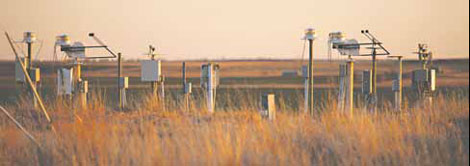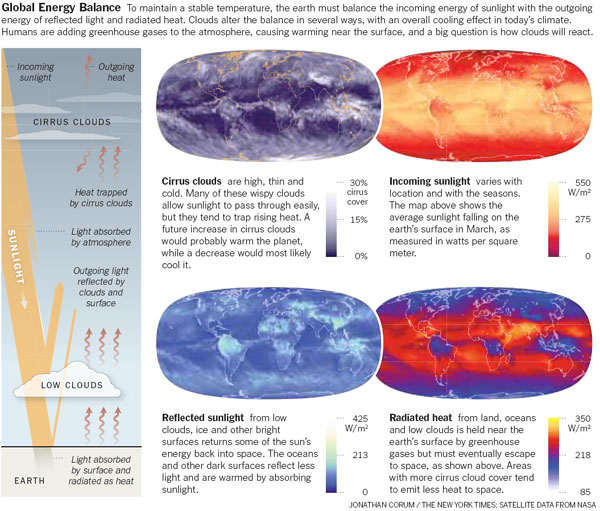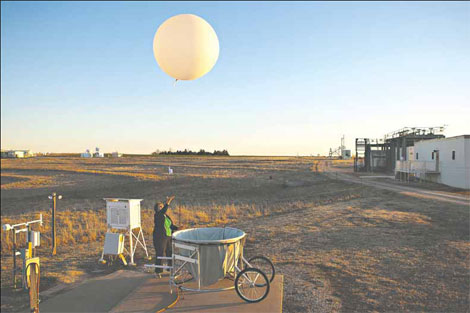Warming's final mystery: clouds
Updated: 2012-05-13 07:48
By Justin Gillis(The New York Times)
|
|||||||
|
A weather balloon and instruments, below, at a facility in Oklahoma monitor cloud cover, which can shield the earth from warming. Photographs by Josh Haner / The New York Times |

Climate change skeptics look to the sky for salvation
Lamont, Oklahoma
IT IS The greatest remaining mystery in climate science: How will clouds change with global warming?
Most scientists believe that clouds will probably have a neutral effect or even amplify the warming, perhaps strongly. But the lack of unambiguous proof has left room for dissent.
Climate change skeptics acknowledge that the release of greenhouse gases will cause the planet to warm. But they assert that clouds - which can either warm or cool the earth, depending on the type and location - will shift in such a way as to counter much of the expected temperature rise.
"Clouds really are the biggest uncertainty," said Andrew E. Dessler, a climate researcher at Texas A&M University in College Station. "If you listen to the credible climate skeptics, they've really pushed all their chips onto clouds."
Richard S. Lindzen, a professor of meteorology at the Massachusetts Institute of Technology, is the leading proponent of the view that clouds will be a savior. His stature in the field - he has been making seminal contributions to climate science since the 1960s - has amplified his influence.
Dr. Lindzen says the earth is not especially sensitive to greenhouse gases because clouds will react to counter them, and he believes he has identified a specific mechanism. On a warming planet, he says, less coverage by high clouds in the tropics will allow more heat to escape to space, countering the temperature increase.
"There's been a lot of scare stuff put out that just doesn't make sense," he said.
At gatherings of climate change skeptics,
Dr. Lindzen has been treated as a star. When he appears at conferences of the Heartland Institute, the primary American organization pushing climate change skepticism, he is greeted by thunderous applause.
But the scientific majority say he has gone beyond any reasonable reading of the evidence to provide a dangerous alibi for inaction.
Natural Thermostats
Clouds do have an enormous effect on the climate. The energy that drives life on earth arrives as sunlight. To remain at a steady temperature, the earth has to return the energy it receives back to space, primarily as heat. Clouds alter the energy flow in both directions.
On balance, clouds cool the earth. Dense, low-lying clouds are responsible for most of that effect, because they reflect sunlight back to space. Many high, thin clouds have the opposite influence, allowing incoming sunshine to pass through but effectively trapping heat that is trying to escape.
Humans are perturbing the earth's heat balance by releasing greenhouse gases, which also block heat trying to escape. But an exact forecast of the planet's warming is difficult for several reasons, especially the question of how clouds will react. Researchers are virtually certain the amount of water vapor in the atmosphere will rise with temperature. But that does not say much about the type or location of clouds that will condense from the vapor.
The most elaborate computer programs have agreed on a broad conclusion: clouds are not likely to change enough to offset the bulk of the human-caused warming. Some predict that clouds could actually amplify the warming trend sharply through several mechanisms, including a reduction of some of the low clouds that reflect a lot of sunlight back to space. Other computer analyses foresee a neutral effect.
A major goal of climate research is to improve the way clouds are represented in computer analyses, and some of the most important data for that is streaming from a hilltop in rural Oklahoma, near the town of Lamont, where the United States Department of Energy runs the world's largest facility for measuring the behavior of clouds.
Recently, $30 million worth of new radars have been installed in Oklahoma and at other research facilities, promising a better view of the innards of clouds. Satellites are also supplying better data, and theories of the atmosphere are improving. "I feel like we're on our way to doing a lot better," said Anthony D. Del Genio, a researcher with NASA.
A Theory of Heat Escape
Dr. Lindzen agrees that carbon dioxide is a greenhouse gas, calling people who dispute that point "nutty." He also agrees that the level of it is rising because of human activity and that this should warm the climate.
But for more than a decade, Dr. Lindzen has said that when surface temperature increases, the columns of moist air rising in the tropics will rain out more of their moisture, leaving less available to be thrown off as ice, which forms the thin, high clouds known as cirrus. Just like greenhouse gases, cirrus clouds act to reduce the cooling of the earth, and a decrease of them would counteract the increase of greenhouse gases.
Dr. Lindzen calls his mechanism the iris effect, after the iris of the eye, which opens at night to let in more light. The earth's "iris" of high clouds would be opening to let more heat escape.
When Dr. Lindzen published this theory, in 2001, he said it was supported by satellite records over the Pacific Ocean. But other researchers said the methods he used to analyze the data were flawed and his theory made assumptions that were inconsistent with known facts.
Waiting, and Its Risks
Today, most mainstream researchers consider Dr. Lindzen's theory discredited. He does not agree, but he has had difficulty establishing his case in the scientific literature. Dr. Lindzen published a paper in 2009 offering more support for his case, but once again scientists identified errors, including a failure to account for known inaccuracies in satellite measurements.
Dr. Lindzen acknowledged that the 2009 paper contained "some stupid mistakes" in its satellite data. Last year, he tried offering more evidence for his case, but after reviewers for a prestigious American journal criticized the paper, Dr. Lindzen published it in a little-known Korean journal.
Dr. Lindzen says other scientists are determined to suppress any dissenting views. They contend that he misrepresents the work of other researchers.
"If I'm right, we'll have saved money" by avoiding measures to limit emissions, Dr. Lindzen said. "If I'm wrong, we'll know it in 50 years and can do something."
But mainstream scientists counter that society's impulse to wait only heightens the risks.
Ultimately, it will become obvious how clouds are reacting. But that could take decades, scientists say, and if the answer turns out to be that catastrophe looms, it would most likely be too late. By then, they say, the atmosphere would contain so much carbon dioxide as to make a substantial warming inevitable, and the gas would not return to a normal level for thousands of years.
Many of his colleagues in the M.I.T. atmospheric sciences department are critical of Dr. Lindzen's stance.
"Even if there were no political implications, it just seems deeply unprofessional and irresponsible to look at this and say, 'We're sure it's not a problem,'" said Kerry A. Emanuel, another M.I.T. scientist. "It's a special kind of risk, because it's a risk to the collective civilization."
The New York Times

(China Daily 05/13/2012 page9)
